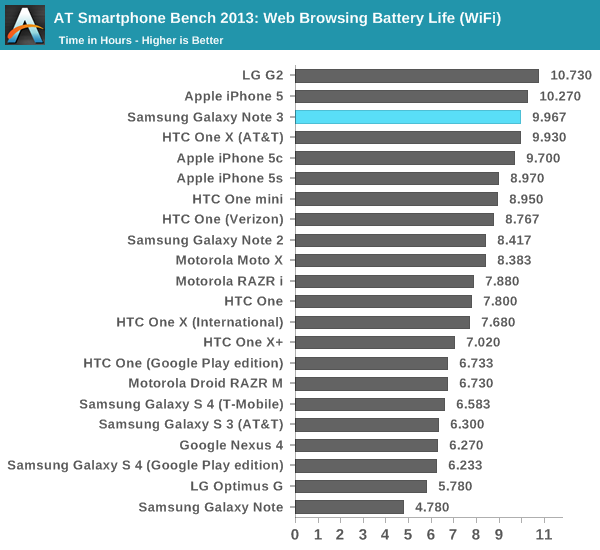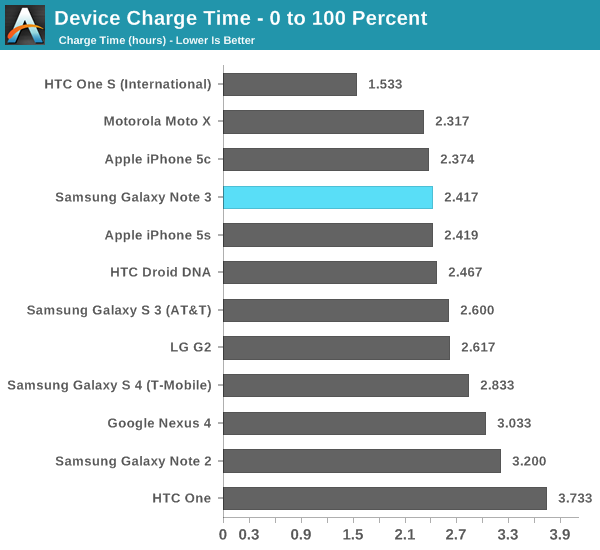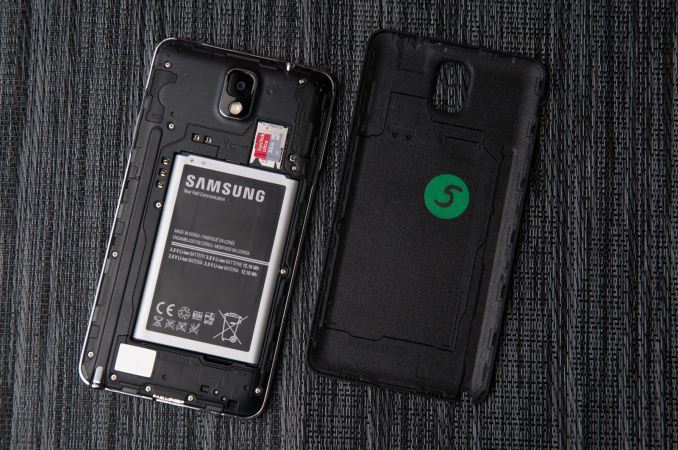Samsung Galaxy Note 3 Review
by Brian Klug on October 1, 2013 9:00 AM EST- Posted in
- Smartphones
- Samsung
- Mobile
- Android 4.3
- galaxy note 3
Battery Life
Battery life remains probably the single largest differentiator for devices lately, and of huge concern to enthusiasts and normal shoppers alike. We’ve already caught a glimpse of how well 8974 fares from a power perspective inside the LG G2, a device that posted some seriously impressive battery numbers. The Note 3 we’re looking at is also 8974 based since it’s a T-Mobile model, and thus we expect the same kind of battery life.
With this generation of Note, battery gets even larger. The Note started with a then quite large 9.25 watt hour battery, then Note 2 moved to 11.78 watt hours, and Note 3 now moves to a very large 12.16 watt hour battery with of course the newest 3.8V chemistry and all that comes along with it. Display size goes up, but those power gains are offset in other places.
After we talked about the panel self refresh features in the G2 a few people reached out and let me know that this feature has been shipping for a while in some phones, and it’s easy to check for. If we look under the display subsystem we can see that the same MIPI_CMD_PANEL type 9 is used, which refers to this type of interface.
Qualcomm HWC state: MDPVersion=500 DisplayPanel=9
define MIPI_CMD_PANEL ‘9’
Our battery life tests are unchanged and consist of a set of popular webpages that are loaded on a schedule with the display set to exactly 200 nits and repeated until the battery runs out and the device dies on both WiFi and cellular data connections. In this case that means T-Mobile LTE which is 10 MHz FDD in my market, I haven’t had a chance to run the Note 3 on HSPA+ yet, or complete the call test (which is starting to get ridiculous, and probably breaks 24 hours in the case of the Note 3).

On LTE the Note 3 does very well, coming just shy of the pack of iPhones, at just over 8 hours. Interestingly enough it’s just north of the G2s as well, which do have a smaller battery but also smaller display. The Note 3 also is the first device to ship with Qualcomm’s QFE1100 envelope tracker solution from the RF360 front end portfolio, which lowers power consumption by up to 20 percent and heat dissipation by up to 30 percent by allowing the power amplifiers to follow the desired output waveform. There’s more on that later in the cellular section.

On WiFi the Note 3 does better by 22 percent, but not the kind of huge jump I’m used to seeing between cellular and WiFi testing. This tells me the Note 3 battery life is really gated by the display, which is almost always the largest consumer of power in a device. That said the Note 3 does very well all things considered, especially in comparison to the APQ8064 (Fusion 3) phones which came before it, like SGS4. New silicon and new process inside MSM8974 definitely helps move battery life forward here with the race to sleep game.
Charging is an interesting story on the Note 3, but primarily because of what doesn’t change. The Note 3 continues to use Samsung’s tablet charging specification and charger, which has 2 amps of maximum output. The Note 3 draws 2 amps over a considerable amount of the charging curve, like other Samsung devices (in the linear part of the charge curve). USB 3.0 doesn’t change things up here quite yet with the new supported charge voltages that are coming eventually with the power delivery specification.

The Note 3 does charge faster overall compared to the SGS4 however thanks in part to the new PMIC (PM8941) which is part of the overall 8974 platform story.











302 Comments
View All Comments
ddriver - Tuesday, October 1, 2013 - link
You really think the snapdragon can encode 4k on the go? Heck, desktop systems are not capable of doing that and they are CONSIDERABLY more powerful. Also, considering the octa core is pretty much the same performance, it should support 4k recording as well if it was in software. It does smell like hardware encoding.TheNotQuiteSilentBob - Tuesday, October 1, 2013 - link
Please correct me if I'm wrong, but doesn't LTE actually has a lower peak-to-average power ratio on the device side versus 3G?LTE uses SC-FDMA on the uplink channel which has a lower PAPR than CDMA (which is used in both the uplink and downlink channel in most 3G technologies). OFDMA is used in the downlink only, meaning its high PAPR and its problematic infulences are affecting the base station and not the user equipment.
I'm sure the ET still has a beneficial effect on power consumption, but I'm assuming the effect is less significant, as LTE was designed with full awareness to the PAPR issue.
Brian Klug - Tuesday, October 1, 2013 - link
Versus WCDMA the PAPR on LTE is higher-Brian
TheNotQuiteSilentBob - Tuesday, October 1, 2013 - link
Your'e talking about the OFDMA used in the downlink, but what about the SC-FDMA in the uplink? I'm positive its PAPR is lower than the CDMA used in both channels of WCDMA and its evolutions.DougFrippon - Tuesday, October 1, 2013 - link
The statement saying USB3.0 doesn't make any difference is so FALSE. There is a number of youtube video showcasing USB3.0 vs USB2.0 with the note3, and wether they test it againt itself (USB3.0 ON or OFF, btw did you guys just forget to enable USB 3.0 all together? because it's not enabled by default as it warns the user it might cause problems with the phone while activated). USB 3.0 is always about TWICE as fast.While USB 3.0 has a theoratical speed of around 10times more than USB 2.0, doubling transfer speed is pretty significant!
Anand you should edit that part ASAP IMO.
Brian Klug - Tuesday, October 1, 2013 - link
As stated above, I have no USB 3.0 toggle on my Note 3, hence the statement that it is broken.http://cl.ly/image/2j1U2b2D2S2i
-Brian
DougFrippon - Tuesday, October 1, 2013 - link
I don't understand. Look at this : http://www.youtube.com/watch?v=34p3YYeWwes#t=1m45sSomethings wrong..
Death666Angel - Tuesday, October 1, 2013 - link
If I had the money to spend, I'd get this. But it is still a device of compromises. I'm interested in a 6.5" 1200p device (IPS or Super AMOLED+). I'm heavily thinking about the Samsung Galaxy Mega 6.3, but I think I'll stick with a Galaxy Nexus as my phone and a Nexus 7 2013 as a tablet, since I already have a 5GB data plan card for 18 more months and 7" is small enough to get put into anything I waer in winter. :DaeeroO - Tuesday, October 1, 2013 - link
Hello, is there any chances to review SD Card speeds through system/usb/There are "80 mb/s+" on the market but as far i remember sgs4 wont support these speeds.
http://forums.androidcentral.com/samsung-galaxy-s4...
http://www.sandisk.com/products/memory-cards/micro...
Voldenuit - Tuesday, October 1, 2013 - link
"CPU performance is honestly excellent."Considering the benchmark shenanigans Samsung was found to be using by ars technica, the use of the word "honestly" will come to be seen as ironic in the future.
Since Samsung has been repeatedly caught cheating in benchmarks on the products, why did Anandtech accept the performance figures prima facie?